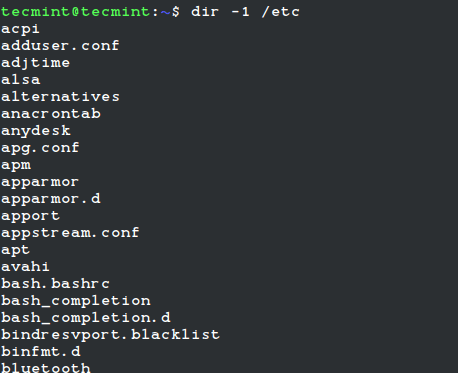Introduction
The ‘dir’ command is a powerful tool in Linux that allows users to list the contents of directories. It is similar to the ‘ls’ command but with some variations in options and output formatting. In this comprehensive guide, we will explore how to use the ‘dir’ command with different options and arguments in Linux. Whether you’re a beginner or an experienced Linux user, this guide will provide you with a thorough understanding of the ‘dir’ command’s capabilities and help you optimize your usage for various tasks.
1. What is the ‘dir’ Command in Linux?
The ‘dir’ command is a utility in Linux used to display the contents of directories. It is commonly available on various Linux distributions and serves a similar purpose to the ‘ls’ command, which is widely used for listing files and directories. However, ‘dir’ offers its own set of options and arguments for customized directory listing.
2. Basic Syntax of the ‘dir’ Command
Before we delve into practical examples, let’s understand the basic syntax of the ‘dir’ command:
dir [options] [directory][options]: These are optional parameters that modify the behavior of the ‘dir’ command.[directory]: This is the directory for which you want to list the contents. If not specified, the current directory is used by default.
Now, let’s explore practical examples to illustrate the usage of the ‘dir’ command with various options and arguments.
3. Listing Files and Directories with ‘dir’
The simplest use of the ‘dir’ command is to list the files and directories in the current directory. You can do this with the following command:
dirThis command will display a list of files and directories in the current directory.
4. Sorting File and Directory Listings
You can use the ‘-r’ option to reverse the order of listing, displaying entries in reverse order:
dir -rThis command will list files and directories in reverse order.
5. Displaying File Sizes in Human-Readable Format
To display file sizes in a more human-readable format, you can use the ‘-h’ (human-readable) option:
dir -hThis command will show file sizes in a format like “1K,” “2M,” or “3G” to represent kilobytes, megabytes, or gigabytes, respectively.
6. Showing Hidden Files and Directories
By default, the ‘dir’ command does not display hidden files and directories (those starting with a dot, such as “.config”). To show hidden entries, use the ‘-a’ (all) option:
dir -aThis command will list all files and directories, including hidden ones.
7. Recursive Directory Listing
To list the contents of directories recursively (including subdirectories), you can use the ‘-R’ (recursive) option:
dir -RThis command will display a recursive listing of files and directories in the current directory and its subdirectories.
8. Filtering Files by Extension
If you want to list files with a specific file extension, you can use the ‘*.[extension]’ pattern. For example, to list all ‘.txt’ files, you can use:
dir *.txtThis command will display a list of files with the ‘.txt’ extension.
9. Displaying File and Directory Permissions
The ‘dir’ command can also display file and directory permissions using the ‘-l’ (long format) option:
dir -lThis command will provide detailed information about each entry, including permissions, owner, group, size, modification date, and name.
10. Printing Directory Entries in a Single Column
To print directory entries in a single column, use the ‘-1’ (one column) option:
dir -1This command will display entries in a single-column format, making it easier to read.
11. Redirecting ‘dir’ Output to a File
You can redirect the output of the ‘dir’ command to a file using the ‘>’ operator. For example, to save the directory listing to a file called ‘directory_listing.txt,’ use:
dir > directory_listing.txtThis command will save the directory listing to the specified file.
12. Using ‘dir’ with Wildcards
Wildcards are powerful when used with the ‘dir’ command. For instance, to list all files and directories starting with the letter ‘a,’ you can use:
dir a*This command will display entries that start with ‘a.’
13. Conclusion
In conclusion, the ‘dir’ command in Linux is a versatile tool for listing files and directories with various options and arguments. Whether you need a basic directory listing, want to sort entries differently, display human-readable file sizes, or perform more advanced filtering and redirection, ‘dir’ can help you efficiently manage your file system.
By understanding the ‘dir’ command’s basic syntax and exploring the practical examples provided in this guide, you’ve gained valuable insights into its capabilities. Whether you’re a beginner or an experienced Linux user, mastering the ‘dir’ command will enhance your file management skills and boost your productivity.
As you continue your Linux journey, keep experimenting with the ‘dir’ command and discover how it can simplify directory listing tasks and streamline your workflow. Whether you’re organizing files, searching for specific entries, or automating tasks, the ‘dir’ command is a valuable tool in your Linux toolbox. Happy directory listing!
